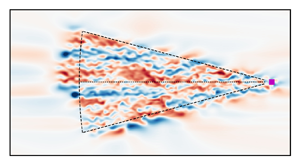doi:10.1017/jfm.2024.54 Kuwata & Suga Reynolds number dependence of turbulent flows over a highly permeable wall
JFM Papers
Prediction and control of two-dimensional decaying turbulence using generative adversarial networks
-
- Published online by Cambridge University Press:
- 21 February 2024, A19
-
- Article
-
- You have access
- Open access
- HTML
- Export citation
Robust relation of streamwise velocity autocorrelation in atmospheric surface layers based on an autoregressive moving average model
-
- Published online by Cambridge University Press:
- 21 February 2024, A20
-
- Article
-
- You have access
- HTML
- Export citation
Asymptotic scaling relations for rotating spherical convection with strong zonal flows
-
- Published online by Cambridge University Press:
- 23 February 2024, A22
-
- Article
-
- You have access
- Open access
- HTML
- Export citation
Connecting transonic buffet with incompressible low-frequency oscillations on aerofoils
-
- Published online by Cambridge University Press:
- 23 February 2024, A23
-
- Article
-
- You have access
- Open access
- HTML
- Export citation
Momentum transfer across an open-channel, turbulent flow
-
- Published online by Cambridge University Press:
- 23 February 2024, A24
-
- Article
-
- You have access
- HTML
- Export citation
Rotor aeroacoustic response to an axisymmetric turbulent boundary layer
-
- Published online by Cambridge University Press:
- 23 February 2024, A25
-
- Article
-
- You have access
- Open access
- HTML
- Export citation
The modulation of coherent structures by the near-wall motions of particles
-
- Published online by Cambridge University Press:
- 23 February 2024, A26
-
- Article
-
- You have access
- HTML
- Export citation
The merger of co-rotating vortices in dusty flows
-
- Published online by Cambridge University Press:
- 26 February 2024, A27
-
- Article
-
- You have access
- Open access
- HTML
- Export citation
Large-eddy simulation-based reconstruction of turbulence in a neutral boundary layer using spectral-tensor regularization
-
- Published online by Cambridge University Press:
- 27 February 2024, A28
-
- Article
-
- You have access
- HTML
- Export citation
Bi-global stability of supersonic backward-facing step flow
-
- Published online by Cambridge University Press:
- 26 February 2024, A29
-
- Article
-
- You have access
- Open access
- HTML
- Export citation
Multistability of elasto-inertial two-dimensional channel flow
-
- Published online by Cambridge University Press:
- 26 February 2024, A30
-
- Article
-
- You have access
- Open access
- HTML
- Export citation
Erratum
Analytical models for pressure-driven Stokes flow through superhydrophobic and liquid-infused tubes and annular pipes – ERRATUM
-
- Published online by Cambridge University Press:
- 21 February 2024, E1
-
- Article
-
- You have access
- Open access
- HTML
- Export citation
Front Cover (OFC, IFC) and matter
FLM volume 981 Cover and Front matter
-
- Published online by Cambridge University Press:
- 28 February 2024, p. f1
-
- Article
-
- You have access
- Export citation

































